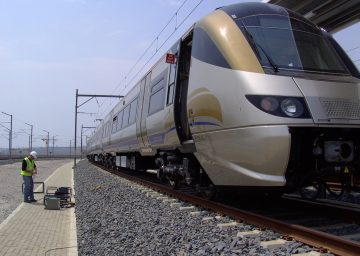Rail EMC Management Plans
Eurofins E&E UK has extensive experience in producing EMC Management Plans, sometimes referred to as EMC Control Plans, for Railway projects.
Why have a Railway EMC Management Plan?
An EMC management plan sets out the processes to ensure that overall EMC exists for the project works that are being carried out at a particular railway project. It forms a key part of suite of EMC documentation for the project designed to show that the new works are in compliance with the EMC Directive.
Identifying areas of concern
The Railway EMC Management Plan usually identifies EMC areas of concern in sufficient detail for the relevant party to reduce or overcome all concerns before the project hand-over stage.
The new project works usually comprise the procurement of apparatus/systems which must be suitably tested against railway-specific standards such as the EN 50121-X series. An EMC Management Plan specifies the relevant standards for each apparatus/system being procured. It also highlights potential interference issues between new and pre-existing apparatus.
It is the purpose of the EMC Management Plan to make sure that the design teams within the project understand these EMC issues. Failure to do so usually results in significant delays at the commissioning/hand-over stage. Resolution of problems at the commissioning stage often result in operational limits being imposed that were not originally envisaged.
Typical railway EMC issues include
- Touch voltage; high touch voltages usually lead to equipment malfunction or failure, they also lead to electric shock.
- Traction package harmonics; modern traction packages cause very high order harmonics of the mains frequency. The high frequency can lead to cross-talk and radiation problems.
- Feeding arrangements; the design of the feeding arrangements has a very great effect on the EMC properties of the railway. The EMC properties of a particular design can sometimes be forgotten when designers become focused on other issues such as greater power transmission, mechanical reliability or lower cost.
- Harmonics, flicker and unbalance; both AC and DC railways are not an ideal load for an electricity supply network operator. Significant disturbance can be created to the electricity supply if planning rules are not followed.
- Signalling and communications equipment; the frequencies and field strengths that signalling and communication equipment require should be planned so that sufficient EMC is allowed between them and known harmonic frequencies from traction arrangements.
- Cable management; various types of cables are usually laid down next to each other. These include high and low voltage cables, data cables and signalling and telecommunications cables. Data corruption in sensitive cables can occur due to nearby high-voltage cables.
- Zoning and equipment approvals; making sure that equipment supplied is approved, compliant and suitable for use. Note that Network Rail PADS is not in itself sufficient for ‘proving’ EMC.
How we can help
Eurofins E&E UK’s Engineers have extensive experience in this field and can help you through the process so as to try to eliminate unforeseen EMC Railway related delays.
Contact the Expert Services team at our York office for more information.














 During the holiday period, our E&E UK offices and laboratories will only be open on selected days. If you have any questions, please contact the appropriate team who will be pleased to help.
During the holiday period, our E&E UK offices and laboratories will only be open on selected days. If you have any questions, please contact the appropriate team who will be pleased to help.
